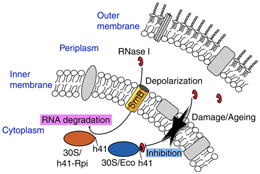Research Abstract
16SリボソームRNAのヘリックス41による細菌RNase T2の特異的な阻害
Specific inhibition of bacterial RNase T2 by helix 41 of 16S ribosomal RNA
2011年11月22日 Nature Communications 2 : 549 doi: 10.1038/ncomms1553

リボヌクレアーゼ(RNase)T2は、細菌のペリプラズム層において、細胞外RNAの分解に関与する。大腸菌(Escherichia coli)において、30SリボソームサブユニットはRNase T2(大腸菌ではRNase Iと呼ばれる)の特異的阻害因子として長らく知られていたが、この相互作用の生化学的機構と生理学的役割については、どちらも未解明であった。本研究では、ハイブリッドのリボソーム作製と変異解析によって、大腸菌16SリボソームRNAのヘリックス41(h41)が、RNase Iの特異的な阻害に重要な役割を担っていることを示す。特に、h41変異株は定常期での生存率が低く、分離後殺傷タンパク質SrnBを発現させると、激しい細胞溶解を引き起こした。これらの表現型異常は、RNase Iによる著しいRNA分解に伴って起こる。したがって、16S rRNAのh41は、RNase T2の潜在的な細胞毒性に対応する上で、宿主細胞に対する生理学的な恩恵をもたらしている。
- 独立行政法人 産業技術総合研究所 生物プロセス研究部門
- 東京大学大学院 新領域創成科学研究科 メディカルゲノム専攻
Ribonuclease (RNase) T2 is involved in scavenging exogenous RNAs in the periplasmic space of bacteria. In Escherichia coli, although the 30S ribosomal subunit has long been known as a specific inhibitor of RNase T2 (designated as RNase I in E. coli), both the biochemical mechanisms and physiological roles of this interaction remain to be elucidated. Here we show, by creating hybrid ribosomes and mutational studies, that helix 41 (h41) of the E. coli 16S ribosomal RNA has a crucial role in the specific inhibition of RNase I. Notably, h41-mutant strains exhibit a lower survival rate at stationary phase and severe cell lysis when the post-segregation killing protein SrnB is expressed. These phenotypic defects accompany significant RNA degradation caused by RNase I. Thus, h41 in 16S rRNA provides a physiological benefit for the host cells in coping with the potential cytotoxicity of RNase T2.

